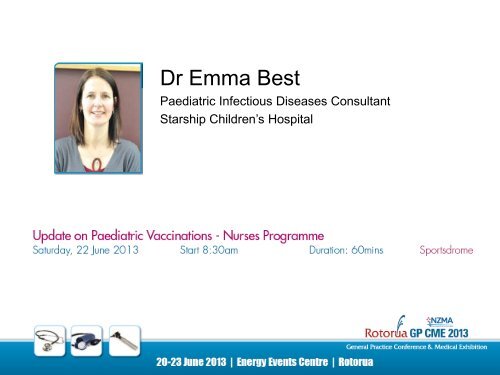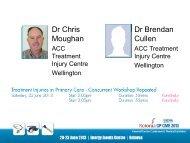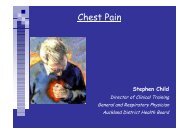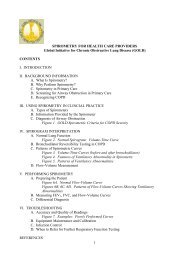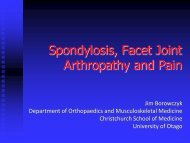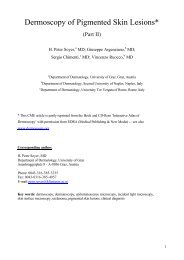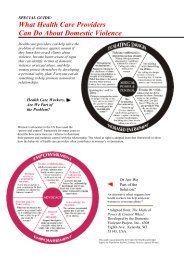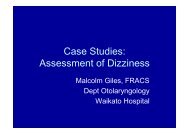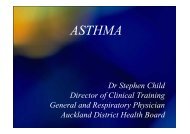Update of Paediatric Vaccinations
Update of Paediatric Vaccinations
Update of Paediatric Vaccinations
You also want an ePaper? Increase the reach of your titles
YUMPU automatically turns print PDFs into web optimized ePapers that Google loves.
Dr Emma Best<br />
<strong>Paediatric</strong> Infectious Diseases Consultant<br />
Starship Children’s Hospital
Vaccine preventable diseases<br />
Dr Emma Best<br />
Senior Lecturer, Department <strong>of</strong> <strong>Paediatric</strong>s, University<br />
<strong>of</strong> Auckland<br />
<strong>Paediatric</strong> Infectious Diseases Specialist<br />
Starship Children’s Hospital<br />
Acknowledgements for slides<br />
Dr. Cameron Grant, Associate Pr<strong>of</strong>essor, <strong>Paediatric</strong>s, University <strong>of</strong> Auckland<br />
<strong>Paediatric</strong>ian, Starship Children’s Hospital, Auckland<br />
Dr Nikki Turner, Director, Immunisation Advisory Centre, University <strong>of</strong> Auckland<br />
Dr Anusha Ganeshalingham PICU fellow intensive care for pertussis info<br />
Google Images
Immunisations again…
Declarations<br />
• Today am invited speaker by GSK who have paid my<br />
travel and accommodation<br />
• Do not accept honoraria<br />
• Participant in research groups with consumables funded<br />
by Wyeth (Pfizer) and GSK<br />
• Member <strong>of</strong> the Anti-infectives committee <strong>of</strong> Pharmac
Outline<br />
Describe vaccine preventable diseases which<br />
I still see<br />
• Using presentations and complications<br />
• To help understand importance <strong>of</strong> vaccinating<br />
still and the public health significance<br />
• Discuss aspects <strong>of</strong> prevention <strong>of</strong> the<br />
disease and vaccine uptake
Immunology made simple<br />
Vaccines stimulate body’s defence<br />
mechanisms (immune system) against an<br />
infection<br />
Help immune system detect and destroy<br />
infection when encountered in the future<br />
without development <strong>of</strong> significant<br />
symptoms or complications <strong>of</strong> that disease<br />
www.science.org.au/immunisation.html
Some vaccines can provide herd immunity<br />
Indirect protection from infection caused by<br />
immune individuals
Exposure to antigens?
Will use Photos to introduce some<br />
vaccine preventable diseases and some<br />
<strong>of</strong> their complications
Name the vaccine preventable<br />
disease
Explain what caused the bleeding<br />
Coughed so hard that she has burst the blood vessels on the<br />
surface <strong>of</strong> her eyes
“100 day<br />
cough”<br />
Whooping cough<br />
Pertussis<br />
Illness with<br />
paroxysms <strong>of</strong><br />
coughing, plus<br />
whoop, apnoea and<br />
vomiting.
Presentation <strong>of</strong> pertussis varies<br />
with age .. and immunisation status<br />
• Infant<br />
• Apnoea and/or cyanosis and/or paroxysmal cough<br />
• Children<br />
• Non-immunised cough increasing in severity over<br />
several weeks rapidly repeated, forceful coughs<br />
followed by desperate gasps<br />
• Well between paroxysms<br />
• Immunised – milder disease – still cough, less forceful
Presentation <strong>of</strong> pertussis<br />
varies with age<br />
• Adult<br />
• Persistent cough,worse at night and <strong>of</strong>ten<br />
paroxysmal<br />
• Awoken by a ‘choking sensation’<br />
• scratchy throat, sweating attacks<br />
• Post-tussive vomiting and whoop
Every 3-5 years escalating epidemics<br />
at the end <strong>of</strong> 2011 – it was that time<br />
again, and proving to be a record<br />
breaker
Number <strong>of</strong> pertussis notifications by week<br />
reported, 2010 - 2013<br />
ESR, Pertussis Report: April 2013.
NZ epidemic statistics are being mirrored around the world – in the<br />
UK
USA..
Australia
34<br />
Admissions to SSH PICU…and<br />
counting
3 deaths<br />
And cohorting up to 4 apnoeic babies<br />
per bay (4 times this epidemic)
Critical Pertussis<br />
• Malignant or<br />
fulminant<br />
• Infants<br />
• 6/10 will be<br />
hospitalized in
To control pertussis you have to do<br />
immunisation well<br />
Increase coverage from < 80% to 80- 90% and you decrease disease burden 10 fold,<br />
Increase coverage to 95% or greater and you get another 10 fold reduction
Pertussis hospital discharge rate in NZ<br />
per 100,000 person years<br />
J Paed Child Health 2007 Somerville, Grant et al
Vaccination has changed pertussis<br />
epidemiology<br />
Primary vaccination:<br />
4-6<br />
Unvaccinated or<br />
partly vaccinated<br />
infants: susceptible<br />
Booster vaccination:<br />
Prolonged protection<br />
6-10 years<br />
Susceptible adults:<br />
reservoir <strong>of</strong><br />
pertussis<br />
No additional booster:<br />
immunity wanes
Why are pertussis outbreaks<br />
occurring worldwide?<br />
• Vaccination does not change the<br />
periodicity <strong>of</strong> epidemics<br />
• Immunity wanes – perhaps faster than<br />
imagined<br />
• The current vaccine is not perfect and<br />
needs very good coverage
Why is pertussis in NZ so bad?<br />
• Very infectious and imperfect vaccine<br />
• + NZ has not achieved good coverage<br />
• + NZ has not achieved timeliness<br />
• + NZ has changed our schedule several<br />
times (including dropping a dose in 1970’s)<br />
• + NZ has poverty and crowded housing<br />
issues
Protect the young<br />
immunise …<br />
• Pregnant women, post partum<br />
• Older siblings/school aged children<br />
• Close contacts – fathers, grandparents<br />
• Early childcare workers<br />
• Healthcare workers (!)<br />
• Give vaccines on time and boosters
Name the Vaccine preventable disease<br />
affecting this newborn baby?
What is this complication from the same<br />
vaccine preventable disease?
Congenital cataracts – opaque<br />
lenses
Rubella<br />
• Was a common childhood<br />
illness -mild symptoms<br />
• Transmission by respiratory<br />
secretions<br />
• Rash is similar to many other<br />
infections<br />
• enlarged lymph nodes (back <strong>of</strong><br />
neck, behind ears)
But for newborns whose mothers<br />
acquire rubella in the first<br />
trimester …..<br />
Blueberry muffin<br />
baby - due to bone<br />
marrow failure<br />
Inflammation<br />
• Liver<br />
• Lungs<br />
• Bone marrow<br />
Cataracts<br />
Nerve deafness<br />
Heart defects<br />
Microcephaly (small brain)<br />
Mental retardation<br />
Behavioural problems
Rubella in New Zealand<br />
New Zealand Immunisation Handbook 2011
Rubella in New Zealand<br />
• Not common<br />
• Between 2005 and 2010, 49 cases <strong>of</strong> rubella<br />
were notified.<br />
• 43 cases in children < 9 year<br />
• Worldwide, less developed countries <strong>of</strong>fer<br />
only monovalent measles vaccine (India,<br />
Indonesia, Timor) so no control/monitoring<br />
<strong>of</strong> rubella
Measles<br />
Conjunctivitis, rash (cough) look<br />
miserable/sick!
Measles<br />
• Transmission by respiratory secretions<br />
• Highly infectious<br />
• Rash is similar to many other infections<br />
• Measles<br />
• Days 2-4: Fever, red eyes, runny nose, Koplik spots<br />
• Day 3-7: Maculopapular rash (confluent)<br />
• Child most unwell day 1-2 <strong>of</strong> rash<br />
• Complications in 10%<br />
• Diarrhoea and dehydration<br />
• Otitis media, pneumonia, croup<br />
• Encephalitis 1:1,000 cases
1969-1970<br />
introduced<br />
1990 MMR<br />
Two dose<br />
schedule 1992,<br />
changed to 15 mths in 1996<br />
Deaths in early 90’s and one in 1997 outbreaks
Measles in New Zealand<br />
• Epidemics still occur but immunisation<br />
has increased the time between them<br />
and many less cases<br />
• To prevent epidemic 95% <strong>of</strong> the<br />
population must be immune<br />
• Vaccine efficacy <strong>of</strong> 90-95%<br />
• Hence 2 dose schedule needed<br />
• WHO global eradication goal
Name vaccine preventable disease and<br />
country where these resurgent cases<br />
still seen
Poliomyelitis NZ 1915-2000<br />
Western pacific<br />
polio free since<br />
2000<br />
Imported Case <strong>of</strong> Poliomyelitis, Melbourne, Australia, 2007- 22-yr-old<br />
Pakistani student who had travelled home to Nthern Pakistan on holiday
• Measles, rubella and polio are examples <strong>of</strong><br />
• herd immunity<br />
• and how we are part <strong>of</strong> both a mobile and global<br />
community<br />
• Polio will be eradicated but is not yet!<br />
• South East Asia is aiming for measles<br />
eradication ..but it is years away<br />
• Millions receive monovalent measles vaccine (M<br />
not MMR) so areas with little rubella control
Tetanus<br />
u<br />
Clinical term for muscular rigidity caused by<br />
the toxin produced by Clostridium tetani<br />
u<br />
Spores found everywhere in environment<br />
particularly manure/soil, not “infectious” or<br />
passed between people<br />
u<br />
Easily introduced to a wound at time <strong>of</strong> injury<br />
especially deep penetrating dirty wounds
New Zealand, tetanus<br />
New Zealand Immunisation Handbook 2011
New Zealand tetanus<br />
• Last 15 years, 30 cases <strong>of</strong> tetanus (2 cases<br />
per year in NZ) notified*<br />
• Mostly older adults - vaccinated ‘years<br />
ago’, no booster<br />
• Children – all unimmunised (4)
Starship experience with tetanus
• Difficult to achieve full immunisation in<br />
families with fixed anti-immunisation beliefs<br />
• Publicity around cases increases discussion<br />
and may help some reconsider stance<br />
Tetanus - a good reminder that for<br />
some diseases there is no herd<br />
immunity
Haemophilus influenzae type b (Hib) causes<br />
meningitis, periorbital cellulitis or<br />
epiglottitis<br />
Epiglottitis<br />
Fever, breathing difficulties, to<br />
painful swallowing, drooling and then<br />
complete airway obstruction
Haemophilus influenzae type b…………<br />
used to be the paediatrician’s bread and butter
Cases<br />
60<br />
Hib laboratory confirmations 1990 - 1995<br />
and notified cases 1996 - 2010<br />
50<br />
Source: Immunisation Advisory Centre, University <strong>of</strong> Auckland<br />
40<br />
30<br />
20<br />
10<br />
0<br />
1st 4th 3rd 2nd 1st 4th 3rd 2nd 1st 4th 3rd 2nd 1st 4th 3rd 2nd 1st 4th 3rd 2nd 1st 4th 3rd 2nd 1st 4th 3rd<br />
1990 1991 1992 1993 1994 1995 1996 1997 1998 1999 2000 2001 2002 2003 2004 2005 2006 2007 2008 20092010<br />
Pre immunisation was the commonest cause <strong>of</strong><br />
bacterial meningitis in children<br />
1 in 350 NZ children aged < 5 years had an episode <strong>of</strong><br />
invasive Hib infection
Hib epidemiology<br />
• Transmission by direct contact and<br />
respiratory secretions<br />
• Immunisation reduces carriage <strong>of</strong> bacteria<br />
in nose<br />
• Preschool children are ones affected so<br />
immunisation works very well - provide<br />
immunity for crucial age<br />
• If 80% <strong>of</strong> population vaccinated disease<br />
virtually disappears<br />
Leung B , Best EJ et al ‘Haemophilus influenzae type b disease in Auckland children<br />
during the Hib vaccination era, 1995–2009.’ NZ Med Journal, Nov 2012<br />
1-2 cases per year, disease still same spectrum, most unimmunised
Neisseria meningitidis<br />
Meningococcaemia<br />
Meningococcal meningitis (brain inflammation)
Meningococcal<br />
epidemiology<br />
Asymptomatic<br />
colonisation<br />
5 to 15% <strong>of</strong> population<br />
Carriage increased by<br />
smoking (also<br />
passive), crowding,<br />
viral infections<br />
Respiratory droplet and<br />
secretion spread,<br />
then infection in those<br />
at increased risk<br />
Meningococcal<br />
bacteriology<br />
Not as simple<br />
as Hi type b<br />
5 serogroups<br />
that cause<br />
disease<br />
A, B, C, W135<br />
and Y
Which New Zealanders?<br />
• Those in crowded houses<br />
• Doubling <strong>of</strong> risk with the addition <strong>of</strong> 2 adolescents or adults to<br />
a 6-room house (Baker PIDJ 2000;19 )<br />
• Age < 5 years, especially age 6 to 12 months<br />
• Maori and Pacific children (2 to 3x increased<br />
risk)<br />
• Household contacts 600x risk in week after<br />
index case<br />
• Students in hostels (adolescence the other risk<br />
group)<br />
• …anyone ..
Meningococcal disease
Age range<br />
Meningococcal Vaccines available<br />
• No longer MenzB<br />
• Conjugate meningococcal C<br />
• Polysaccharide quadrivalent A,C,W135 Y<br />
Any but not long<br />
lasting protection<br />
particularly in infants<br />
All ages and long<br />
lasting<br />
Over 2 years and<br />
lasts about 5 years<br />
• Menactra conjugate A,C,W135,Y<br />
Over 9months and<br />
long lasting
Otitis media<br />
Pneumonia (and empyema)<br />
Meningitis pus and inflammation in the membrane<br />
around the brain<br />
Streptococcus pneumoniae<br />
Pneumococcal disease
Pneumococcal<br />
epidemiology<br />
Asymptomatic<br />
colonisation in 30-<br />
60% <strong>of</strong> young<br />
children<br />
Changed by season,<br />
viral illness, antibiotic<br />
prescribing,<br />
socioeconomic<br />
status<br />
Pneumococcal<br />
bacteriology<br />
Also not simple<br />
90 (!) serotypes<br />
Some more<br />
invasive than<br />
others<br />
Invasive disease for<br />
some<br />
65yrs,<br />
medical conditions<br />
Non invasive disease<br />
Ear infections,<br />
pneumonia
S. pneumoniae substantial burden<br />
<strong>of</strong> disease<br />
Estimated annual hospital admissions per<br />
100,000 in NZ children aged
<strong>Paediatric</strong> pneumococcal disease in New<br />
Zealand<br />
• Life threatening<br />
• Each year ≈ 150 cases <strong>of</strong> pneumococcal meningitis<br />
and bacteraemia in children under 5 years old<br />
• 10-11 deaths<br />
• 13-26 cases <strong>of</strong> severe long-term disability<br />
• Pneumonia<br />
• 3000 admissions per year<br />
• 20 to 40% due to pneumococcal infection<br />
• Otitis media<br />
• A large proportion <strong>of</strong> antibiotic prescriptions
Pneumococcal vaccines<br />
• 23 valent polysaccharide vaccine<br />
• Not immunogenic in children < 2 years old<br />
• Conjugate vaccines<br />
• Antigens from most invasive pneumococcal<br />
serotypes<br />
• Joined (conjugated) to a carrier protein<br />
• More complex molecule - creates an immune<br />
response in infants
Percentage <strong>of</strong> Serotypes Isolated<br />
Serotypes Causing IPD in Children
PCV vaccines<br />
Prevenar<br />
Serotypes<br />
4, 6B, 9V, 14, 18C, 19F, 23F<br />
CRM 197 Diphtheria carrier protein<br />
PCV7 licensed in<br />
2000<br />
Introduced NZ June<br />
2008<br />
Serotypes<br />
Prevenar13 4, 6B, 9V, 14, 18C, 19F, 23F 1, 5, 7F 3, 6A, 19A<br />
CRM 197 Diphtheria carrier protein<br />
Synflorix<br />
Serotypes<br />
4, 6B, 9V, 14, 18C, 19F, 23F 1, 5, 7F<br />
NTHi protein D T D NTHi protein D<br />
Switched<br />
to PCV 10<br />
June 2011<br />
3 + 1 schedule<br />
6wks, 3mths, 5mths and 15 mths
New Zealand IPD rates<br />
90% reduction in VT IPD<br />
70% reduction in overall IPD<br />
Heffernan et al INVASIVE PNEUMOCOCCAL DISEASE IN<br />
NEW ZEALAND, 2010
Young girl with a rash
Varicella – common childhood<br />
illness<br />
• COMMON YES – 90% have had<br />
chicken pox by age 14 yrs<br />
• So common that complications also<br />
common!
What is this common<br />
associated skin complication?<br />
Cellulitis
What is this rare complication <strong>of</strong> this VPD?<br />
Necrotising fasciitis – “flesh eating bug”<br />
Typically Streptococcus pyogenes
Not so benign - severity <strong>of</strong> chicken pox<br />
• Mild disease 50 lesions (most breakthrough<br />
disease in vaccinated children is 1000 lesions<br />
• Although more severe in immunocompromise<br />
most deaths and hospitalisations occur in<br />
healthy people/children
SSH PICU again; varicella<br />
admissions<br />
• 10 years review – 2-3 children per year<br />
• 4 deaths<br />
• Currently looking at all hospitalisations<br />
due to varicella across New Zealand over<br />
2 years in
Varicella vaccine<br />
• Varicella vaccine available since 1996 (live attenuated vaccine)<br />
• Recommended but not funded, (about 17% uptake)<br />
• Vaccines available in New Zealand:<br />
• Varilirix Varivax<br />
• Quadrivalent MMRV vaccine (Priorix-Tetra or ProQuad)<br />
• Zostavax (herpes zoster vaccine for adults ≥ 50 years <strong>of</strong> age)<br />
• Recommended for children from age 12m to 12yrs<br />
1 dose effective for 80%, very effective at reducing serious infection<br />
• Administered at 15m (with MMR, Hib & PCV10)<br />
• Second dose (debatable) at 4yrs with MMR (effectiveness 2 doses<br />
>95%)
Varicella vaccine<br />
USA<br />
USA since 1995<br />
Australia –<br />
AUSTRALIA<br />
recommended 2003,<br />
funded since 2005
Common questions raised when talking about<br />
vaccinating chicken pox<br />
• Why – common childhood disease and better<br />
immunity from wild infection?<br />
• Vaccine immunity only lasts 20 years?<br />
• More shingles<br />
• 2 doses?<br />
• Use MMRV or MMR + V ?
Common questions raised when talking about<br />
vaccinating chicken pox<br />
• Why? common and nasty<br />
• Vaccine immunity only lasts 20 years – no<br />
reason to believe this – live viral vaccine and<br />
antibody should present lifelong but without wild<br />
virus may need other boosting<br />
• More shingles? Less shingles after vaccine<br />
– theoretical concern <strong>of</strong> increased shingles in<br />
those whilst we “eradicate varicella with vaccine”<br />
– development <strong>of</strong> zostavax<br />
Reid S NZMJ 2012 125; 1354
Varicella vaccine or MMRV<br />
• Give the varicella vaccine or the MMRV??<br />
• So 1 jab (MMRV) or 2 jabs (MMR + V) at 15 months?<br />
• NZ MOH recommends MMR+V at 15 months due to risk <strong>of</strong> febrile<br />
seizures<br />
• What is the risk for febrile seizures?<br />
• 1 additional febrile seizure is expected per 2500children<br />
vaccinated with MMRV when compared with MMR + V (if receive it<br />
aged 1-2 yr)<br />
• No increased risk seen in those aged 4-6yrs who received MMRV<br />
• Weigh up with other costs – pain <strong>of</strong> extra injection, risk <strong>of</strong> falling<br />
behind schedule, missing opportunity <strong>of</strong> vaccinating
• A very current vaccine preventable<br />
disease - PERTUSSIS<br />
• Global community, herd immunity and not<br />
Polio, rubella<br />
Measles<br />
Tetanus<br />
• Bacterial vaccines - the old’ish and new’ish<br />
• HIB, MENINGOCOCCAL AND PNEUMOCOCCAL<br />
• What’s in store?<br />
Varicella
Key messages<br />
• VPD -a reality in NZ and cause morbidity and<br />
death<br />
• Improved coverage and timeliness will change<br />
this<br />
• We are part <strong>of</strong> a global community <strong>of</strong> people<br />
(measles) and microbes (tetanus)<br />
• Effective bacterial vaccines give new invasive<br />
disease priorities - surveillance is important<br />
• Pertussis control is complicated<br />
• New vaccines such as varicella likely to impact<br />
positively both at population and individual level


